Having a good online presence will allow you to attract more customers to your brand and even achieve more than you are aiming for. A good online presence involves being consistent with how you present your brand to the world, and a brand style guide ensures that consistency.
Here are the topics we’ll tackle in this post:
- What is the difference between a business and a brand?
- How can having a style guide improve your online presence?
- Where are style guides used?
- What should be included in the style guide?
- What makes a good style guide?
Let’s get started.
What Is a Brand and Why Is Branding Important?
If you’re not seeing any good results from your video marketing, it might be because you are not incorporating your brand into it. Incorporating your brand means using your brand elements across all platforms and in everything that you do. That includes your brand fonts, colors, and styles.
People are more likely to remember things, people, and objects that don’t change, so you should aim for consistency when doing any activity online. Being consistent results in a solid brand identity, which is one of the things that can make a brand succeed.
You might be thinking, “Are brands the same as businesses?” All brands do business but not all businesses are considered brands. Brands are more defined than unbranded businesses because they have their own identities. If you have your own identity and you are embracing it, then you must be stable.
Some examples of brands are Nike, Ikea, Facebook, Amazon, and McDonald’s.
But that’s not to say that non-brands can’t be stable. The thing about unbranded businesses is that they are more flexible because there isn’t any set of guidelines to follow and they are less concerned about their image. They are more focused on selling their products or services.
Examples of a non-brand business are some of the resellers on Amazon and other eCommerce platforms.
How to Create a Brand Style Guide to Improve Your Brand’s Online Presence
Before we talk about how to create a brand style guide, let’s first discuss why you should do it in the first place.
Simply put, a brand style guide contains important details about your brand as well as your brand elements including, but not limited to, fonts, colors, graphical styles, brand messaging, and logo variations, as well as the instructions on how to properly use them.
Your brand elements are part of your brand identity, so if they were used in the wrong way, it might result in misrepresentation and misunderstandings on your audience’s part. That could break your brand. The good news is that if you have a brand style guide, that can be avoided.
So, here’s how to create a brand style guide that can help you have a stronger online presence.
1. Use Your Brand Elements When Designing the Brand Style Guide
This is a no-brainer. Obviously, if you don’t use your brand elements in everything that you do, then people won’t take your brand style guide seriously. Talk the talk, walk the walk. You have to set a good example and show people that you yourself have respect for your brand.
Your brand elements should be present from the outset. When people look at the front cover of your brand style guide, they must know immediately that it is indeed your brand style guide. Use your colors, fonts, and styles, and include imagery that best represents your brand.
2. Talk About Your Brand First and Foremost
Talking about your brand elements on the first page isn’t a good idea. Even though it’s given that it is your brand style guide, you have to tell your audience some information about your brand before anything else. They may know what you do, but not all of them know who you are.
Your brand history is optional. What’s important here is to connect with the audience right from the start with a brief introduction about your brand so they can be interested in flipping the pages and have an idea of why you chose certain elements for your brand.
There are reasons why you picked certain colors, fonts, and styles. Your audience wouldn’t understand those reasons and connect the elements to your brand if they didn’t know your brand enough.
3. Add a Table of Contents
In some cases, people only need to know a few things in your brand style guide before they can get the job done right, which is why having a table of contents is important. For instance, if you work with a graphic designer for your social media ads, the video section in the guide doesn’t concern them.
Plus, going through each page is time-wasting, especially if you’re just looking for one specific thing. A table of contents can help everyone, including you, save so much time. It may just be taking a small portion of your guide, but it makes a huge difference.
4. Tell the Story Behind Your Logo
As cliche as this may sound, the logo is the face of your brand, so it’s the first brand element you must talk about. There’s a story behind your logo. You chose that kind of style for a reason. Tell that story and that reason in the guide so your audience can understand why they should respect it.
But telling them how to respect it is also important. You can do that by being straightforward with them about the dos and don’ts when it comes to your logo, and don’t forget to show examples so everything is clear. Take a look at these logo usage guidelines from SRA Brand Standard Guide:
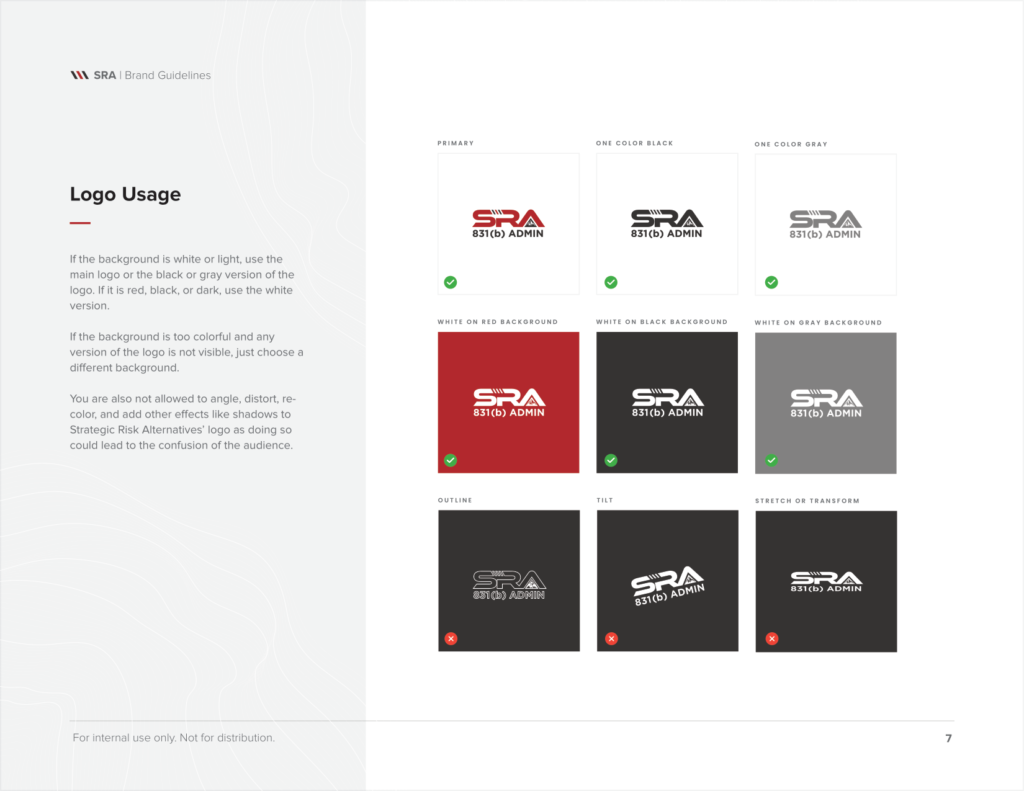
5. Let Your Audience Know Why You Chose Your Colors
We associate certain colors with certain emotions, so your brand colors have an influence on how people will perceive your brand. This is why you must consider the image you want to have when choosing colors. Picking the wrong ones may hinder you from reaching your goals.
It’s also important that you don’t use just one color for your brand so your audience doesn’t get bored. Most, if not all, brands have primary, secondary, and tertiary colors and they have different uses. Here is a sample brand color palette from SRA Brand Standard Guide:
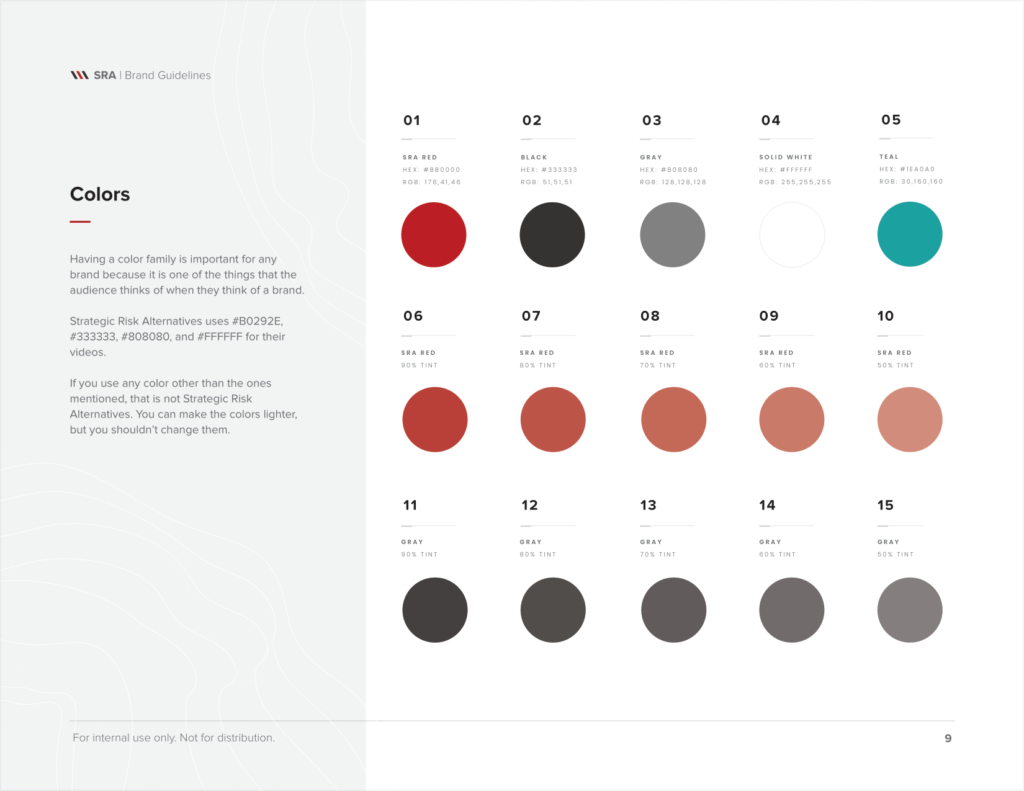
Different colors have different uses, and you have to be clear about your rules when it comes to your brand colors in your guide. This is to avoid brand misrepresentation.
6. Tell Why You Picked the Font
Just like colors, the fonts you use also have an impact on how you will be perceived. For instance, if the font has a lot of curves, you might be seen as flexible and easygoing. If it is too sharp, then you must be a perfectionist, or just orderly.
Regardless of the reason, don’t hesitate to share it with your audience. Here are the fonts Strategic Risk Alternatives use to give you an example:
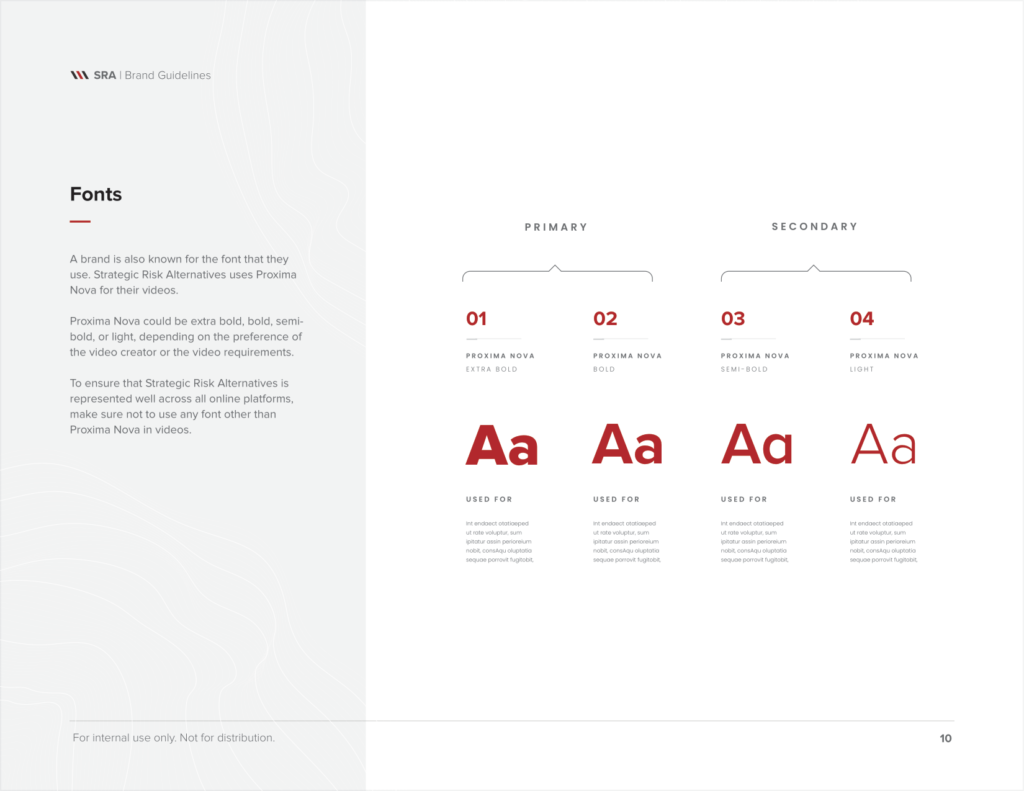
Strategic Risk Alternatives is in the finance industry and they are all about mitigating risks, so sans-serif fonts are better for them than serif ones.
7. Inform Your Audience of What Is Allowed and What Is Not
We talked about logo usage guidelines earlier, but that’s just one of the many brand dos and don’ts you must include in your guide. Apart from logos, you also have to tell people what they should and shouldn’t do when, among others:
- talking about your brand on different platforms
- talking about your brand with other people outside of your circle
- sharing the content you made on their pages
- creating content on behalf of your brand
Clothing is part of this. You want to leave a good impression on your audience, so anyone who wishes to talk on behalf of your brand must look presentable. Being presentable could mean wearing your company uniform or simply wearing clothes that are appropriate for the situation.
You should let them know of the scope and limitations of what they can do involving your brand to avoid problems that might result in brand failure. There isn’t any rule for this. Your brand dos and don’ts depend on what you will and will not tolerate.
8. Talk About the Specifics
The ones we talked about are the basics. If you have standard styles for graphics, videos, advertisements, publications, and other materials, you can include them in the guide. Strategic Risk Alternatives uses video marketing, so there is a video section in their guide that contains guidelines for:
- introductory and closing screens
- lower thirds
- video mark
- video transitions and effects
- music
- other video elements such as those for animation
Your specifics depend on your content and marketing strategies. If you use videos to give value to your audience and promote your brand at the same time, having a video style guide within your brand style guide is the way to go.
9. End With Gratitude
People spent time reading your guide from beginning to end and getting to know your brand better, so thank them before they get to the last page! You don’t have to write a lengthy heartfelt message to them. A simple “thank you” will do.
Here’s a sample Thank You page from SRA Brand Standard Guide:

Conclusion
A brand style guide isn’t optional if you want your brand to succeed. You might be thinking that it’s just another way of wasting money, but letting people know how to properly care for your brand can make your brand identity more solid.
Without a brand style guide, anyone you do business with might handle your brand inappropriately or, worse, poorly. That would result in brand failure, and that’s the last thing that you want to happen.




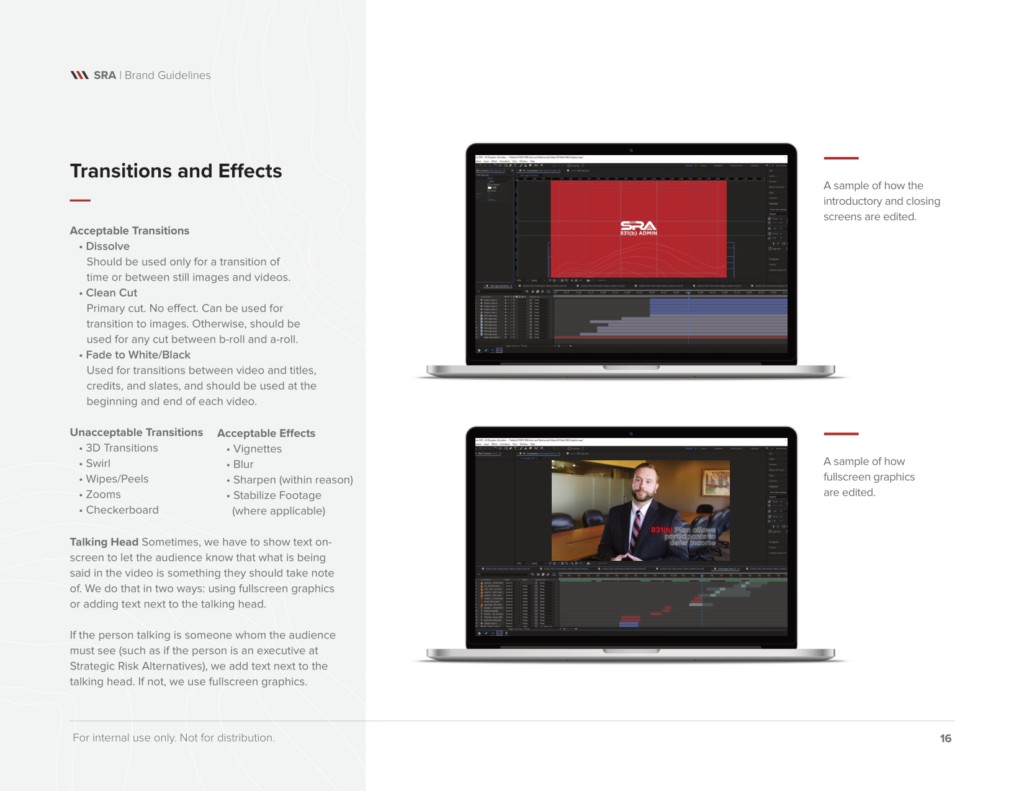

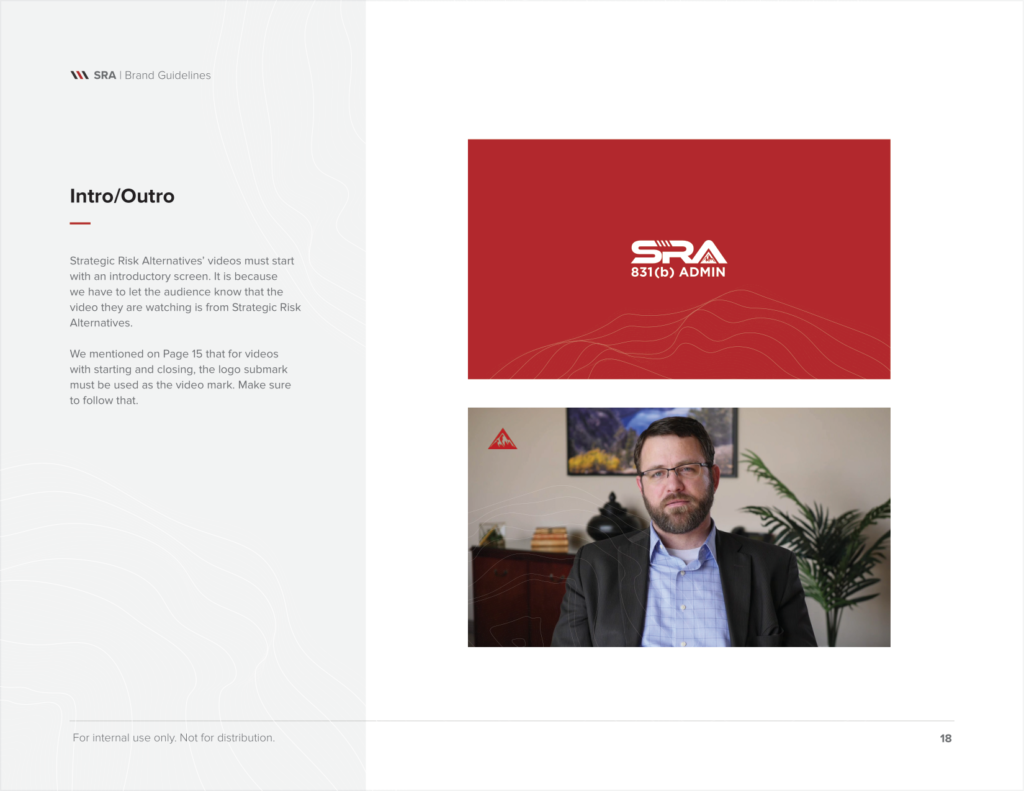




great post!! can you share the PDF SRA brand manual??
arojas.cv@gmail.com